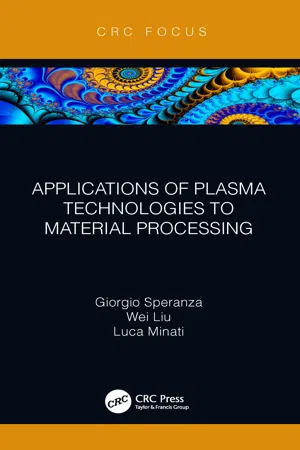
eBook - ePub
Applications of Plasma Technologies to Material Processing
This is a test
- 121 pages
- English
- ePUB (mobile friendly)
- Available on iOS & Android
eBook - ePub
Applications of Plasma Technologies to Material Processing
Book details
Book preview
Table of contents
Citations
About This Book
This book provides a survey of the latest research and developments in plasma technology. In an easy and comprehensive manner, it explores what plasma is and the technologies utilized to produce plasma. It then investigates the main applications and their benefits. Different from other books on the topic that focus on specific aspects of plasma technology, the intention is to provide an introduction to all aspects related to plasma technologies. This book will be an ideal resource for graduate students studying plasma technologies, in addition to researchers in physics, engineering, and materials science.
Features
- Accessible and easy to understand
- Provides simple yet exhaustive explanations of the foundations
- Explores the latest technologies and is filled with practical applications and case studies
Frequently asked questions
At the moment all of our mobile-responsive ePub books are available to download via the app. Most of our PDFs are also available to download and we're working on making the final remaining ones downloadable now. Learn more here.
Both plans give you full access to the library and all of Perlego’s features. The only differences are the price and subscription period: With the annual plan you’ll save around 30% compared to 12 months on the monthly plan.
We are an online textbook subscription service, where you can get access to an entire online library for less than the price of a single book per month. With over 1 million books across 1000+ topics, we’ve got you covered! Learn more here.
Look out for the read-aloud symbol on your next book to see if you can listen to it. The read-aloud tool reads text aloud for you, highlighting the text as it is being read. You can pause it, speed it up and slow it down. Learn more here.
Yes, you can access Applications of Plasma Technologies to Material Processing by Giorgio Speranza,Wei Liu,Luca Minati in PDF and/or ePUB format, as well as other popular books in Sciences physiques & Physique. We have over one million books available in our catalogue for you to explore.
Information
Chapter 1
Introduction
Since the 1980s, gases made of ionized particles have been used to synthesize materials with a specific desired surface chemistry or modify the chemical surface properties of an object. Such an ionized gas is called plasma and is usually referred to as the fourth state of matter in addition to the conventional solid, liquid, and gaseous forms. There is a rather broad variety of plasmas and they can be classified on the basis of different criteria, as summarized in Table 1.1.
TABLE 1.1 Classification of Plasmas Following Different Criteria
| Criteria | Plasma |
| Operating pressure | low-pressure plasma |
| atmospheric-pressure plasma | |
| Thermodynamic equilibrium | thermal or equilibrium plasma (Telectron ≈ Tion ≈ Tgas) |
| non-thermal plasma or non-equilibrium plasma (Telectron >> Tion ≈ Tgas) | |
| low-temperature plasma (Tgas < 2000 K) | |
| high-temperature plasma (Tgas > 2000 K) | |
| Plasma generation | microwave frequency discharge (300 MHz–300 GHz) |
| radio frequency discharge (450 kHz–3.0 MHz; 13.56 MHz) | |
| DC discharge | |
| dielectric barrier discharge | |
| corona discharge | |
| electric arc | |
| hollow cathode discharge | |
| electron beam | |
| plasma torch | |
| alternating current | |
| Type of coupling | inductive coupling |
| capacitive coupling | |
Low pressure and atmospheric plasmas can be distinguished on the basis of the operative pressure. In the first case, plasmas are generated in vacuum chambers where the precursor pressure typically ranges between a fraction of a millibar and 10−4 millibar. Atmospheric pressure plasma jets operate at ambient pressure without the need for complex equipment to reach low pressures. Due to the combination of simplicity, low cost, and wide possibilities of material treatment and modification, at present they are one of the most promising technologies. Plasmas can be classified also on the basis of temperature, that is, thermal equilibrium. In non-thermal plasmas, the temperatures of the electrons and the ions are in a thermal non-equilibrium. Due to the different mass, the temperature of the electrons (i.e., the kinetic energy) ranges between several electron volt (eV), whereas the temperature of the positively charged ions and neutral species is around room temperature. 1 , 2 This corresponds to a quite low overall plasma temperature ranging from 300 K to 1000 K. For this reason, the plasma is also called “cold plasma” and is favorable for the synthesis of materials at low temperature. In high-temperature plasmas, the temperatures are about 107 K, which is typical of fusion plasmas 3 used to produce energy. We will focus on low-temperature, plasmas, which are used to modify the properties of materials.
The common feature of all the plasmas is that they use vaporized chemical compounds or gaseous precursors. In a typical plasma process, the precursor molecules are introduced and ionized in a chamber (the plasma reactor) with selected concentrations. Then, another kind of classification may be done on the basis of the energy source used to generate and sustain the plasma. The source of energy can be thermal energy, a flame, a laser, a microwave or radio frequency (RF), ...
Table of contents
- Cover
- Half-Title
- Title
- Copyright
- Contents
- Chapter 1 ■ Introduction
- Chapter 2 ■ Plasma Reactors
- Chapter 3 ■ Plasma Applications
- Chapter 4 ■ Concluding Remarks
- References
- Index